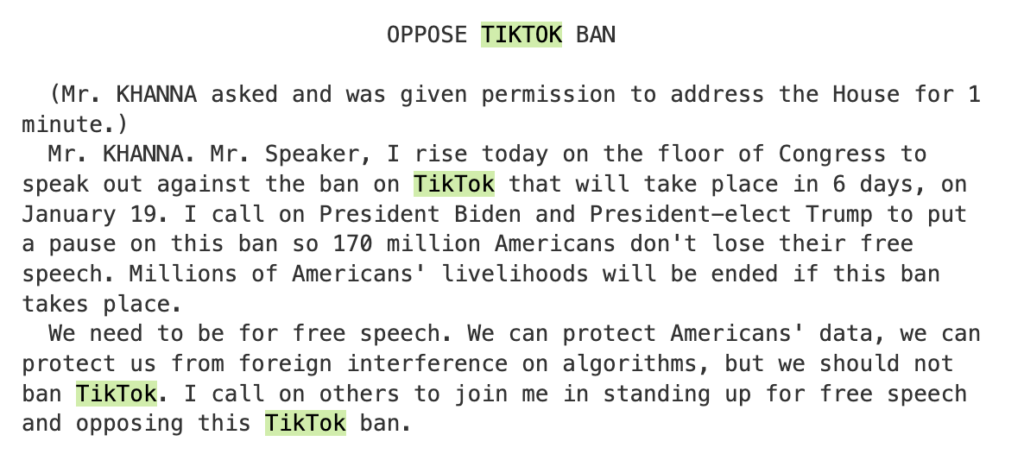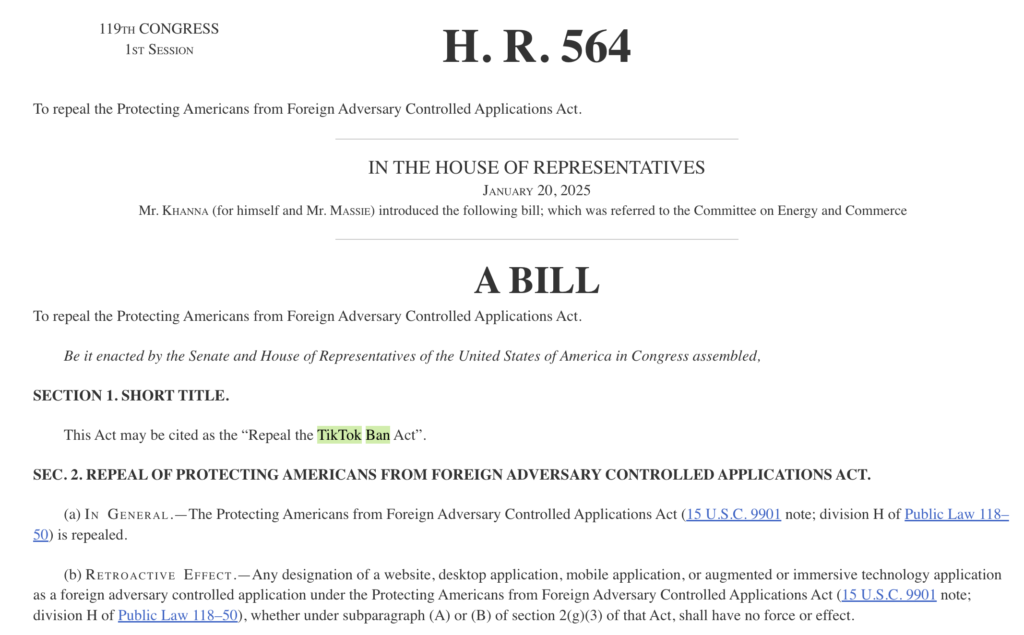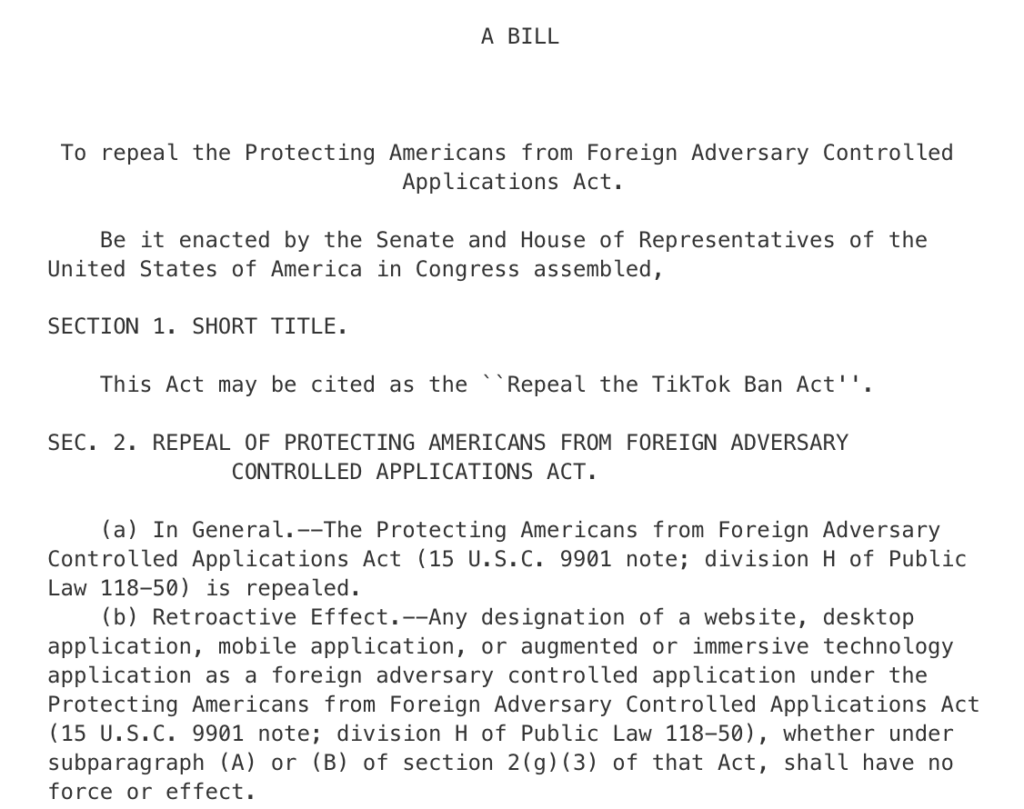3 Win has learned that April 5, 2025, TikTok ban would take effect again in U.S. The Trump administration’s 75-day grace period is set to expire. If ByteDance doesn’t complete the divestment with TikTok by then, TikTok will face:
✅ App store delisting in the US (iOS and Android)
✅ ISP-level access restrictions for existing users
✅ Commercial account fund freezes (FTC compliance review initiated)
The prospect of a TikTok ban in the US is a major blow to Chinese cross-border e-commerce sellers who rely on its traffic. Here are 7 tips you should know!

I. TikTok Ban & Repeal TikTok Ban Act
Interpretation of Executive Orders of TikTok Ban
According to U.S. Congressional Record Vol. 171, No. 6, in January 13, 2025, House of Representatives call on the government to put a pause on TikTok Ban so 170 million Americans would not lose their free speech and damage their livelihoods.

However, the newly-elected US President Donald Trump signed an executive order on January 20, and the 119th US Congress passed the “Repeal TikTok Ban Act”.

Timeline
- August 6, 2020: President Donald Trump signed an executive order to ban TikTok in US on national security grounds, demanding ByteDance sell its US business within 45 days.
- March 23, 2023: TikTok CEO Shou Zi Chew attended a US congressional hearing to address security concerns, but failed to ease lawmakers’ worries.
- January 19, 2024: The Biden administration set a deadline for TikTok to stop serving the US, after which users couldn’t access the platform.
- January 20, 2024: On his inauguration day, Trump signed an executive order, granting TikTok a 75-day reprieve (until April 5, 2025), suspending the ban for renewed negotiations.
- April 2025: TikTok filed an emergency request with the federal court (case No.25-cv-01248) for an extension.
II. Advanced Plans for TikTok Ban
As the clock ticks down towards the potential TikTok ban in the US, slated for January 19, 2025, unless significant intervention occurs, the pressure is mounting, especially for Chinese sellers who have heavily relied on the platform to reach American consumers. The “Protecting Americans from Foreign Adversary Controlled Applications Act” mandates divest-or-ban.

While legal challenges are ongoing, the potential disruption is significant. For Chinese sellers, TikTok often represents a primary channel for brand building, direct sales (via TikTok Shop), and influencer marketing targeting the US market.
7 Must-Know Plans for Chinese Sellers Before TikTok Ban(2025 Update)
Based on my experience in digital marketing, here are crucial steps Chinese sellers should consider right now:
1. Alternative Platforms for TikTok
Never put all your eggs in one basket. If TikTok is your primary channel, it’s time to actively build and engage audiences on alternative platforms.
- Resort to Other Platforms: Explore Instagram Reels, YouTube Shorts, and Pinterest. These platforms offer short-form video formats and strong visual discovery capabilities similar to TikTok. Consider Facebook Shops as well.
- Re-orient Contents: While you can repurpose some content, tailor your strategy to each platform’s unique audience and algorithm. What works on TikTok might need tweaking for Reels or Shorts.
- Start Now: Building a following takes time. Begin cross-promoting your other social profiles on TikTok immediately.
2. Build and Nurture Your Owned Channels
Owned channels are assets you control directly, immune to platform bans or algorithm changes.
- Prioritize Email List Building: Offer incentives (discounts, exclusive content) on TikTok and other platforms for users to sign up for your email list. Email marketing provides a direct line to your customers.
- Develop Your Own Website/eCommerce Store: A dedicated website (perhaps using platforms like Shopify or building a standalone site) gives you full control over branding, customer experience, and data. Invest in Search Engine Optimization (SEO) to drive organic traffic.
- Content Hub: Use a blog on your website to provide value, attract search traffic, and establish authority in your niche.
3. Explore Alternative Marketplaces and Sales Channels
Diversify not just your marketing but also your sales avenues.
- Major Marketplaces: Consider established platforms like Amazon, eBay, Walmart Marketplace, or Etsy (if applicable to your products). Each has a large built-in user base.
- Niche Marketplaces: Research platforms specific to your product category.
- Direct-to-Consumer (DTC): Focus on driving sales directly through your own website, offering a potentially higher profit margin and stronger brand control.
4. Backup Your TikTok Content and Audience Insights
Your TikTok content represents significant time and creative investment.
- Download Your Videos: Systematically save your published videos (without watermarks if possible, using third-party tools cautiously).
- Analyze Performance Data: Capture analytics regarding top-performing content, audience demographics, and engagement patterns. This data is invaluable for informing strategies on other platforms.
- Gather User-Generated Content (UGC): Save positive comments, testimonials, and customer video reviews showcased on TikTok.
5. Redirect Your TikTok Audience
Don’t wait for a potential ban to guide your followers elsewhere.
- Update Your Bio: Ensure your TikTok profile link directs users to a landing page linking to your website, email signup, and other social profiles (e.g., using Linktree or a similar service).
- Use Calls-to-Action (CTAs): Regularly include verbal and text CTAs in your videos encouraging viewers to follow you on Instagram, subscribe to your YouTube channel, or join your email list.
- Offer Incentives: Provide exclusive discount codes or content for followers who connect with you on other platforms.
6. Adapt Your Influencer Marketing Strategy
If you rely on TikTok influencers, pivot your approach.
- Identify Cross-Platform Influencers: Find creators who have a strong traffic not just on TikTok but also on Instagram, YouTube, or other relevant platforms.
- Shift Budget Allocation: Be prepared to reallocate your influencer marketing budget towards campaigns on more stable platforms.
- Explore New Talent: Look for up-and-coming influencers native to platforms like Instagram Reels or YouTube Shorts.
7. Stay Informed and Remain Agile
The landscape surrounding the TikTok ban is constantly evolving.
- Monitor Reputable News Sources: Keep track of updates from major news outlets, tech publications, and legal analyses regarding the ban, potential sale negotiations (like the mentioned possibility involving Elon Musk reported by Bloomberg, though outcomes are uncertain), and policy shifts.
- Be Flexible: Develop these contingency plans but be ready to adapt them based on new developments. Agility is crucial.
- Network and Learn: Engage with other sellers and marketing professionals to share insights and strategies.

Securing Your Business Beyond the TikTok Ban
The potential TikTok Ban in 2025 presents a significant challenge, particularly for Chinese sellers who have found immense success on the platform. However, by proactively implementing these 7 essential contingency plans, you can mitigate the risks and build a more resilient, diversified business.
Focusing on diversifying your marketing channels, building owned assets like email lists and websites, and preparing to redirect your audience are no longer optional—they are critical survival strategies in today’s dynamic digital landscape. The key takeaway from this 2025 update is the urgent need for action. I hope these insights are valuable as you navigate this complex situation.



